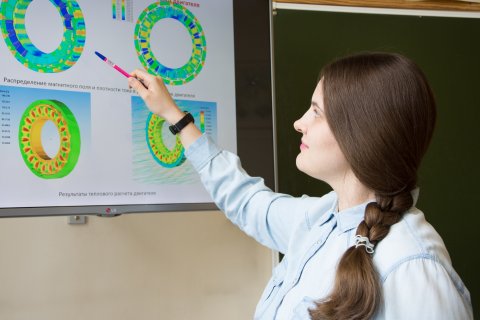Within the groundbreaking field of industrial digitization, researchers from South Ural State University are developing digital twins for electric motors for a big Russian industrial metallurgical company. These developments are unique and have no analogues in Russia or abroad. The results of their research were presented at Global Smart Industry Conference and published in a collection indexed in Scopus.
Digital Twins, Neural Networks and Internet of Things
One of the key projects of the Industry 4.0 concept is digital modelling, monitoring, reporting, and control of equipment online. A digital twin is a software analogue of a physical piece of equipment, modelling the internal processes, technical characteristics, and behaviour of a real object.
Researchers from South Ural State University have been working for many years on the development of unique programs for the creation of digital twin systems for metallurgical and mechanical engineering companies.
.png)
.png)
Photo: Mathematical model of an electric drive
“The foundation of digital twins is a mathematical model which must reflect the physical processes that occur within an object, technology, or piece of equipment. Electric drives consist of three components: the mechanical, electromagnetic components and a transformer, which controls the electromagnetic component and rotates the mechanical component. Each of these components should have several models so that the digital twin was as close to reality as possible. Digital models must consist of a few components, which are connected well with one another and with the physical object,” says one of the project’s authors Nadezhda Kuleva.
To create a connection between the electric drive and its digital twin, SUSU researchers use neural networks for faster, higher volumes of data transfer, the processing of these data, constant revision of the models, and algorithms for controlling the electric drives through self-learning. They also use the Internet of Things (IoT) to obtain data about the physical condition of the object in the early stages and when the equipment is in operation.
Unique Digital Model
The models developed by the group of researchers from the SUSU Institute of Engineering and Technology are unique because the digital twins use several digital models which reflect the different physical processes of an electric drive, which differ not only by the software that they use, but also by their methods of mathematical description.
The researchers have formulated recommendations for the use of different models. The use of digital twins in manufacturing offers a competitive advantage since the obtained data make it possible to foresee mechanical failures. This increases the reliability and safety of production, decreases the need for service personnel, and offers economic advantages.
“We present different types of digital modelling which reflect the electromagnetic processes in the electric drive valve based on synchronized motors with constant magnets. The models that we offer differ not only by the software used, but also by the methods of mathematical description. We were able to show the difference in the results of calculations which were obtained from these simulations and explain the differences in the results. This allowed us to offer recommendations for the application of one model or the other depending on the goal,” explains Nadezhda Kuleva.
Course towards Digitization
Digital industry is one of the key fields at SUSU as a SMART University of Digital Transformations, which is included as a priority task of scientific and technological development not only for our country but for the global scientific community. The development of this field is supervised by Vice-Rector for Informatization Leonid Sokolinsky.
.jpg)
“Our university is located in an industrial region and partners with many companies which have set a goal of moving towards digital industry. Accordingly, they need help with scientific developments and research and development. We have significant achievements in the field of mathematical modelling and in the field of creating digital twins for manufacturing businesses and supercomputer modelling, and we already have industrial clients who need such applications,” says Leonid Sokolinsky.
South Ural State University has significant results of both applied and fundamental character. The university has a lot of experience in creating digital twins for industrial objects. Some examples of such solutions include virtual 3D models of rolling mills and hydroelectric power stations. In addition, research related to developments in the field of artificial intelligence, processing, storage, and mining of bid volumes of data, all of which is absolutely necessary for the digitization of industry, will continue.
Research in the field of digital industry, ecology, and materials science are a priority for the development of South Ural State University’s research and academic work.




